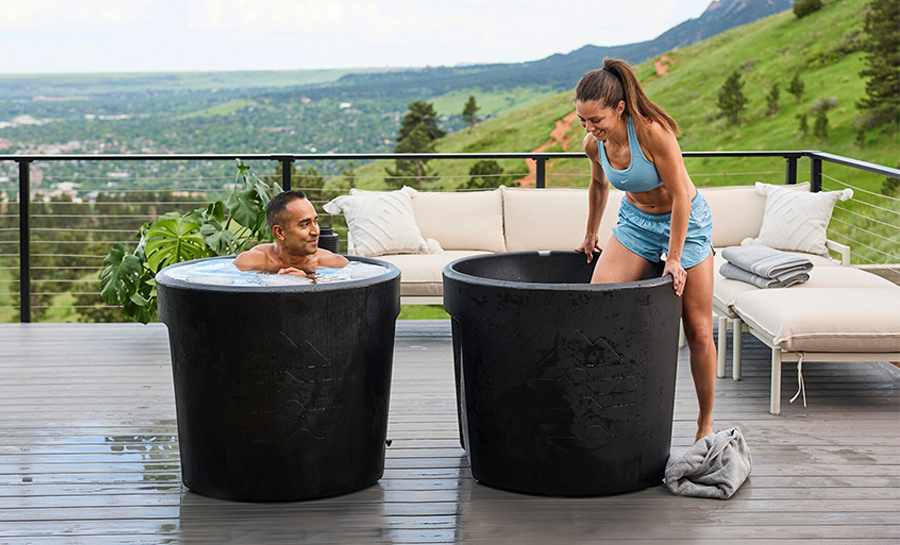
[adinserter block=”1″]
To cold plunge or not to cold plunge – that is the question!
First of all, let’s quickly define cold plunging: the act of immersing your body in water that is below 59 degrees Fahrenheit (15 degrees Celsius).
Cold plunging (also referred to as an ice bath or cold water immersion) is just one type of cold therapy. There is also whole-body cold therapy (typically cold air therapy in a clinical setting) and cryotherapy (which includes several other forms of cold therapies).
If you’re already a fan of cold plunging, this article will validate your admiration with all the of health benefits we’ll share. And if you haven’t yet experienced a cold plunge, then read on to learn more about this unique wellness trend.
Ready to take the [cold] plunge? In this article, you will learn:
- A brief introduction to cold water therapy
- An explanation of what a cold plunge is
- The main health benefits and science behind cold plunging
- Safety precautions and important details to know
- Pro tips and advice to get the most of out it
Read on to learn all about the very popular cold plunge trend and it’s long list of benefits (AKA all the reasons you may want to brave the cold and take the literal plunge).
A Quick Dive Into Cold Water Therapy
Cold water therapy, which cold plunging falls under, refers to receiving the therapeutic benefits of cold water – such as natural pain management, reducing inflammation, post-workout recovery, and a healthier mental state to name a few.
The process involves immersing your body in water that is below 59 degrees Fahrenheit.
From ice baths to cold showers and from plunge pools to dips in rivers and oceans – the healing power of cold water has been used for centuries. Even so, many people still wonder today: “Is cold water therapy just a splash in the wellness trends, or can researchers back up the scientific benefits?”

Top 5 Science-Backed Benefits of Cold Plunges
According to new research, “Cold therapy provides systemic anti-inflammatory relief, increases positive immune response, and parasympathetic nervous system stimulation.”
These studies are showing positive results for reducing inflammation, improved athletic performance and recovery, supporting mood and mental wellbeing, and more. Read on for the main science-backed benefits of cold plunging.
1. Improved Athletic Performance and Recovery
When you work out, your muscles are being stretched and pulled, which can make them feel tender and inflamed after the workout is over.
Cold water is a great way to cool down after exercising because it has regenerative properties that help muscles relax and repair themselves. Cold plunging initiates what’s called the “vasoconstriction” (constriction of the blood vessels) in the skin and extremities. This can in turn help reduce muscle pain and swelling.
In an article on ScienceAlert.com, Johanna Lanner, an expert in muscle physiology from the Karolinska Institute in Sweden, explains how cold water therapy relieves soreness.
She says, “Cooling reduces nerve impulse transmission and thus reduces the level of pain perception. It also induces constriction of blood vessels in peripheral tissues (e.g., muscle) which results in reduced fluid diffusion that may assist in reducing exercise-induced acute inflammation.”
In short, the consensus is that cold plunging post-workout is a great way to help improve athletic performance and recovery.
You can also supplement your post-exercise plunging practice with these 7 Tips to Maximize Recovery After Your Workout
2. Reduce Inflammation
As the previous point mentioned, cold plunges can reduce the inflammation throughout the body in muscles caused from rigorous exercise.
Beyond exercise-related inflammation, cold plunging can reduce other forms of inflammation within the body, whether it’s injury-related or systemic. It boosts the immune system through stimulation of the Vagus nerve, which in turns creates hormonal changes in the body that reduce inflammation. Cold therapy also reduces edema, which is when excess fluid collects in tissues or other areas of the body.
Learn All About the Vagus Nerve and How It Can Calm Your Anxious Nervous System
Cold water therapy has been shown to activate hormonal responses in people suffering from chronic diseases that are associated with inflammation such as depression, fibromyalgia, and rheumatoid arthritis.

Image: icebarrel.com
3. Improved Pain Management and Stress Response
The physical exertion from exercise and life stressors both elicit comparable hormonal responses that impact heart rate and variability. As mentioned above, cold plunging activates the Vagus nerve, which in turn decreases heart rate and promotes a state of relaxation.
This study investigates whether or not the human immune system can be activated by a noninfectious stimulus (aka, cold water), thereby improving the physiological status of the individual.
It concluded that immune health improved when athletic young men were immersed in cold water three times a week for six weeks.
In another study, researchers found that people who took a cold shower were less likely to miss work due to sickness than those taking warm ones – even if the participant was alternating from warm to cold water.
One explanation for that result is responses induced by cold are mainly due to increased activity of the sympathetic nervous system – our fight or flight mechanism that keeps us alive – specifically the hormone noradrenaline.
This is what most likely causes the increased heart rate and blood pressure observed when people are immersed in cold water.
Dr. Rhonda Patrick has shown in her report that noradrenaline levels are five times higher in people who regularly cold plunge.
This article summarized it perfectly with this sentence, “While we don’t want to spend our entire lives in a stressed-out, sympathetic mode, brief and repeated exposure to physical stress (like from cold plunges) may actually improve our overall stress response and immunity.”
Want more ways to boost your immunity? Read 6 Simple, Science-Backed Ways to Strengthen Your Immune System
4. Support Mood, Brain Function, and Mental Health
Cold sea swimmers report improved feelings of wellbeing and similarly, cold water immersion has been found to produce short-term improvement in mindset. One study noted an increase in positive mindset and a decrease in negative mood.
Interestingly enough, people who suffer from depression tend to have certain inflammatory markers, and the benefits of cold water therapy include reducing this specific inflammation while also reducing the symptoms of anxiety and depression.
This is why cold plunging is being referred to as a “non-pharmaceutical supporting therapy.” So while a cold plunge is certainly not a replacement to treating mental health issues, it can be a supportive modality to explore.
There’s also something to be said for the mindset challenge of exposing your body to discomfort and sitting in that discomfort. While you’re in the cold plunge, the goal is to maintain deep, steady breathing despite the sensation of the extreme cold. Over time, this practice fortifies your mindset and ability to tolerate other forms of mental and physical discomfort.
This cold plunge benefit also ties back to athletic performance – the endurance athlete must cultivate and maintain a strong mindset regardless of the challenge or discomfort they face in their training.
5. Can Increase Metabolism
Dr. Paul Lee, an endocrinologist at the Garvan Institute of Medical Research found cold temperature soaking helps with weight loss as it affects the fat tissues in our bodies.
When you cold plunge, your body has to burn fat and sugar to increase its core body temperature.
According to this article, “Cold water therapy forces stem cells in the body to create brown fat cells instead of white. You want this to happen because brown fat cells are metabolically active and can burn or oxidize the white fat tissues in the body.”
It goes on to say, “Taking a cold plunge in an ice barrel can activate the brown adipose and muscles in your body. Once activated, Irisin and FGF will be released. These two hormones burn up the white fat tissues resulting in weight loss. Ten to fifteen minutes of shivering increased the release of this hormone to a level identical to what you would get from an hour of moderate exercise.”
How to Cold Plunge + Potential Risks and Safety Details to Know Before
How can you prepare for a cold plunge? How long should you cold plunge for?
While some sources suggest that 50-59 degrees Fahrenheit (10-15 degrees Celsius) is the optimal range, there is not a standard temperature for cold plunging, so the temperature can vary based on the individual. Most water temperatures range from 38-60 degrees Fahrenheit.
Cold plunging can be done in any cold body of water. While some sources suggest that 50-59 degrees Fahrenheit (10-15 degrees Celsius) is the optimal range, there is not a standard temperature for cold plunging, so the temperature can vary based on the individual. Most water temperatures range from 38-60 degrees Fahrenheit.
This article is a great resource filled with everything a first-time plunger needs to know, summarized below:
- Warming up for your cold plunge with five minute cold showers will help you understand your body’s responses so you feel more prepared
- Activate your parasympathetic nervous system with deep breathing prior to and during your cold water immersion
- A target plunge time of two to three minutes will maximize benefits, up to 10 minutes
If you are new to cold plunging, start off with higher water temperatures and less time in the water. You can build up gradually as you continue getting acclimated to the experience.
In the market for your own cold plunge?
There are a bunch of options out there these days for having a cold plunge at your house. From DIY horse troughs to expensive modern tubs. A great in-between is the Ice Barrel 300. The Ice Barrel 300 is the latest product from IceBarrel.com. The 300 is a sleek, fully insulated cold plunge tool that makes it easy to bring ice baths to your routine. Just add ice or a chiller to keep the water cold 24/7. Use code: SIMPLY100 for 100$ off the purchase of a IceBarrel 300. Get one here.
Cold Water Therapy and the Benefits of Cold Plunging: The Takeaway
From better circulation to improved digestion, we hope you’ve soaked in all the amazing health benefits of cold plunging and cold water therapy provided in this article.
Depending on where you live, many cities now have cold plunge or cold water therapy facilities. You can purchase a day pass to try it out with a specialist on site. If you want to try it at home, start with a cold shower! If you’re ready to take the plunge and get one for yourself, the Ice Barrel 300 is currently the most popular cold plunge on the market.
Potential Risks of Cold Plunging
As much as they can have positive effects, the shock to your body from cold plunging can also have negative effects. Therefore, cold water therapy is not recommended for everybody.
It’s important to be aware of your health and any medical conditions before trying any form of cold water therapy for the first time.
It is especially not recommended for people who have heart disease, high blood pressure, diabetes or are pregnant. Additionally, cold water therapy may not be the right choice if you are elderly or have pain from an underlying condition such as a torn tendon.
With cold plunging comes the risk of hypothermia, an increased risk of arrhythmias or heart attack, hyperventilation or even drowning. These risks are heightened for those with any of the above medical conditions or when done in a river or large body of water.
Due to these risks, it is recommended to cold plunge with a professional and/or with other people around.
Finally, less is more. There is debate in the science world about the optimal frequency for cold plunging. While there is no definitive answer, the majority seems to point to taking days off and limiting the amount of time you cold plunge each session to avoid overexposure.
Always be sure to consult with your doctor before trying any new wellness modality.
All included information is not intended to treat or diagnose. The views expressed are those of the author and should be attributed solely to the author. For medical questions, please consult your healthcare provider.
[adinserter block=”1″]
Credit : Source Post






